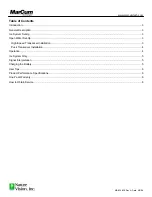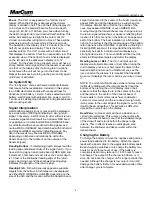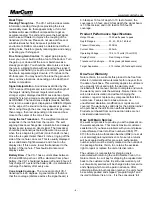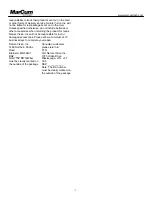
www.marcumtech.com
- 5 -
Zoom
- The VX-1 is equipped with a "bottom zoom"
feature. When the ZM key is depressed the circular
display is divided in half. The right half of the display (12
to 6 o’clock on the dial) will become the entire depth
range (20, 40, 80, or 160 foot) you chose when turning
the depth range knob to your desired depth setting. This
will be indicated by a red light at the zero mark (12
o'clock) and another red light at 6 o'clock. These will be
stationary and will not move while in the Zoom mode.
The backside of the display (6 to 12 o'clock) is the other
half of your split screen display. This is the Zoom
window portion. The VX-1 comes with a bottom zoom
that displays the bottom 5 feet in an expanded view. This
expanded view of the bottom 5 feet is what is displayed
on the left side of the split screen display (6 to 12
o'clock). For the Zoom to be activated, you must have a
strong bottom return signal (Red) that equals or exceeds
one foot on the display dial. If a strong return signal is
not achieved the unit will not go into the Zoom mode.
Repeat the process by turning up the gain and try again
until Zoom is activated.
Ice System Only
The “Ice System” comes with some additional features
that require further explanation. Included in this system
is an ABS electronics shuttle with recessed trays for
transducer and battery, 12-volt / 7-amp sealed lead acid
battery, wall charger with alligator clips, power cord, VX-
1 sonar unit, self-aligning transducer, and gimbal bracket
with mounting knobs.
Signal Interpretation
Hard-bottom readings (rock or gravel) will be displayed
by a wide band of RED light indicating a strong return
signal. Conversely, a soft bottom (mud or silt) will return
a weaker signal and will result in a narrower RED band
or possibly even a combined RED and ORANGE band.
A soft bottom with weed growth will often appear as a
narrow RED or ORANGE band combined with both solid
and broken GREEN segments indicating weeds. Any
fish in the weeds may show as RED or ORANGE
depending on fish size and relationship within the
transmit beam (in the middle or on the outside of the
transmit signal).
Reading Bottom
- In interpreting depth, always read the
leading edge (shallowest side) of the signal return. If you
have a strong signal return (wide band of RED light) and
it starts at 13 feet and ends at 16 feet, the correct depth
is 13 feet or the shallowest leading edge of the return
signal. Anything beyond the shallowest leading edge
indicates the strength of the return signal.
Reading Fish
- Fish will generally appear as separate
targets from the bottom. A fish target can be displayed
as either RED, ORANGE or GREEN, depending on the
size of the fish and the location within the transmit beam.
Larger fish located in the center of the beam (cone) can
appear RED and will be displayed as a wider band on
the display. Smaller fish or fish on the outside of the
cone may appear ORANGE or even GREEN. Fish
moving through the transmit beam may change color as
the return signal strengthens or weakens reflecting their
location. Fish that are right on the bottom can appear as
part of the bottom. The best indication of a fish sitting
right on the bottom is that the leading edge of the bottom
return signal is either ORANGE or possibly a dithering or
flickering RED segment. It is important that the GAIN or
sensitivity be kept to a minimum when displaying a
strong bottom return. Too much GAIN will flood out the
ability to differentiate targets and clutter the display.
Reading Lures or Bait
- The VX-1 will pick up and
display small objects like lures or bait. When tuning the
unit to display your lure or bait, lower the object to the
desired depth and turn up the GAIN until you see the
lure or bait on the display. It is important that the GAIN
be set so it displays the lure or bait as you raise or lower
it.
NOTE: Too much GAIN will cause clutter and may make
it difficult to distinguish other targets like fish near the
bottom. When tuning the unit to display lures or bait,
make sure that the objects are in the center of the hole
and therefore in the center of the transmit beam. If
there’s water current (some lakes have underwater
current or movement) and the lure doesn’t weigh much,
it may move to the outer edge of the signal or out of the
transmit beam altogether. This will make it difficult or
impossible to pick it up on the display.
Dead Zone
- All sonar units will have a dead zone in
certain circumstances. This occurs on sharp drop-offs
where the transmit beam (cone) hits the shallower edge
of the drop-off and returns before the deeper edge
returns. This in effect creates an undisplayed area
between the shallower and deeper water within the
transmit beam.
Charging the Battery
To charge the battery, remove the negative and positive
power leads attached to the battery. Attach the power
leads with alligator clips to the appropriate battery posts.
Basic charging guidelines are to charge the battery two
hours for every three hours of use. If the battery is
completely dead it may take up to 14-18 hours to reach
full charge. The output of the charger is 500 mA or ½
amp. Do not leave the charger on for longer periods than
needed. Although the charger is low output, it can still
damage the battery if left on for extended periods of time
after charge cycle is complete








